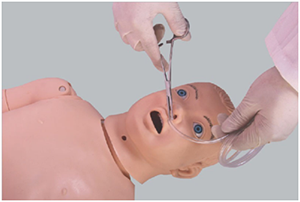

Article tag: Children nasal feeding tube model| medical teaching model|
In practical application, remarkable results have been achieved. Many hospitals and nursing institutions have adopted this model for the training of medical staff, which effectively improves the accuracy and safety of nasal feeding operation. At the same time, p...
In the field of medical care, pediatric nasogastric tube operation is a delicate and critical task. Due to the physiological characteristics of children, the operation of nasal feeding tube not only needs to be accurate, but also needs medical staff to have a high degree of professional skills and meticulous nursing attitude. The emergence of the pediatric nasal feeding tube model undoubtedly provides great help for the training and practical operation of medical personnel, helping to improve the quality of care.
The advanced simulation technology is used to simulate the physiological structure of children's nasal cavity, pharynx and esophagus, which provides a realistic training environment for medical staff. Through the model, medical staff can repeatedly practice the insertion, fixation and feeding steps of the nasal feeding tube, and be familiar with and master the correct operation process and skills. This simulation training not only helps to improve the operation skills of medical staff, but also enhances their self-confidence to ensure that they can complete the nasal feeding task accurately and quickly in the actual operation.

In addition, it has a variety of functions, such as simulating physiological reactions such as breathing and swallowing in children, as well as simulating possible complications, such as aspiration and nasal feeding tube blockage. These functions enable medical staff to have a more comprehensive understanding of the risks and challenges of pediatric nasogastric tube operation during training, so as to be more vigilant and cautious in actual operation to avoid unnecessary risks and injuries
By using the pediatric nasal feeding tube model for training, medical staff can not only improve their operational skills, but also better understand the physiological characteristics and psychological needs of children. This helps them to treat each child more carefully and patiently in practice, and provide more intimate and professional nursing services. At the same time, the use of the model can also promote the communication and learning between medical staff, and jointly improve the quality and level of nursing.
In practical application, remarkable results have been achieved. Many hospitals and nursing institutions have adopted this model for the training of medical staff, which effectively improves the accuracy and safety of nasal feeding operation. At the same time, patients and their families have also expressed recognition and appreciation for this model, believing that it helps to improve the quality of care and the comfort of children.